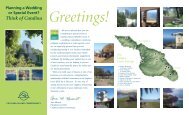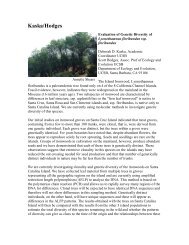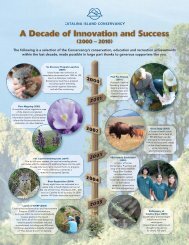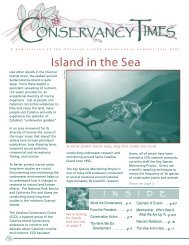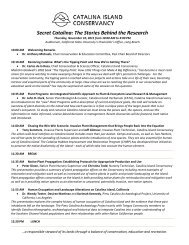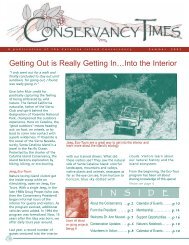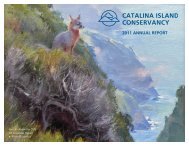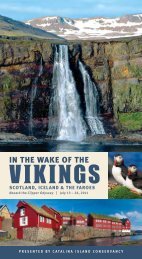Unique and Rare - Catalina Island Conservancy
Unique and Rare - Catalina Island Conservancy
Unique and Rare - Catalina Island Conservancy
You also want an ePaper? Increase the reach of your titles
YUMPU automatically turns print PDFs into web optimized ePapers that Google loves.
Isl<strong>and</strong> Raritycontinued from page 1D. KnappCase Study #1The Santa <strong>Catalina</strong> Isl<strong>and</strong> ShrewWeighing little more than a penny, the Santa <strong>Catalina</strong>Isl<strong>and</strong> Shrew (Sorex ornatus willetti) is believed to bethe rarest mammal on <strong>Catalina</strong>. A subspecies of themainl<strong>and</strong> ornate shrew, this tiny insectivore occurs onlyon Santa <strong>Catalina</strong> Isl<strong>and</strong>. Very little information existsabout its life history, abundance, <strong>and</strong> distributiondespite several attempts to study it over the past twodecades.The <strong>Catalina</strong> Mahogany occurs naturally in only one remotegully on the southwest side of the isl<strong>and</strong>.suppression appears to be a factor in the rarity of someof our plant species, such as the Isl<strong>and</strong> Tree Poppy(Dendromecon harfordii) <strong>and</strong> Felt-leaf Ceanothus(Ceanothus arboreus).We have also introduced many non-native <strong>and</strong> invasiveplant <strong>and</strong> animal species. Introduced animals such asferal pigs (Sus scrofa) <strong>and</strong> bullfrogs (Rana catesbeiana )threaten rare native species on <strong>Catalina</strong> such as theTwo-striped Garter Snake (Thamnophis hammondii)through habitat destruction <strong>and</strong> predation. In addition,it has been estimated that up to 32 of <strong>Catalina</strong>’s nativeplant species have been eliminated from the isl<strong>and</strong> ordrastically reduced due to the impacts of non-nativeherbivores (Thorne 1976). Introduced animals such asMule Deer (Odocoileus hemionus californicus) <strong>and</strong> feralpigs hinder oak production by browsing the younggrowth, disturbing the soil, <strong>and</strong> foraging on acorns.Invasive annual grasses such as Bromes (Bromus spp.)<strong>and</strong> Wild Oats (Avena spp.) also reduce oak seedlinggrowth through crowding <strong>and</strong> water competition.Without the crucial replacement of aging oak trees,<strong>Catalina</strong>’s l<strong>and</strong>scape could look significantly different inthe future as the oaks die off <strong>and</strong> there are none toreplace them.Between 1941, when it was first described, <strong>and</strong> 2002,the Santa <strong>Catalina</strong> Isl<strong>and</strong> Shrew had only been seen <strong>and</strong>documented a total of seven times from Avalon,Middle, <strong>and</strong> Cottonwood Canyons. Since February 2002,monthly monitoring of reptiles, amphibians, smallmammals, <strong>and</strong> invertebrates using permanently placedpitfall trap arrays has led to the capture of twoadditional shrews in Cottonwood Canyon. Recently anintensive study was conducted by the <strong>Conservancy</strong> todetermine the distribution <strong>and</strong> abundance of shrews inthis canyon. More than 10,500 trap nights of effortusing pitfall <strong>and</strong> live-traps were necessary to capturejust three additional individuals of this rare shrewsubspecies. Although notoriously difficult to trap,similar studies on the mainl<strong>and</strong> capture more far moreshrews per effort.The endemic Santa <strong>Catalina</strong> Isl<strong>and</strong> Fox is found on Santa<strong>Catalina</strong> Isl<strong>and</strong> <strong>and</strong> nowhere else.F. StarkeyIt is important to underst<strong>and</strong> the causes of rarity to beable to develop conservation strategies that reduce thelikelihood of a rare species going extinct in the future.Through research, restoration of natural ecologicalprocesses, <strong>and</strong> removal of threats such as invasive plants<strong>and</strong> animals, the <strong>Catalina</strong> Isl<strong>and</strong> <strong>Conservancy</strong> is helpingto protect the rare <strong>and</strong> unique plant <strong>and</strong> animal speciesof Santa <strong>Catalina</strong> Isl<strong>and</strong>. The help of the localcommunity <strong>and</strong> visitors is critical to our success.Like past accounts, these most recent sightings suggestthat the Santa <strong>Catalina</strong> Isl<strong>and</strong> Shrew may be closelyassociated with riparian <strong>and</strong> wetl<strong>and</strong> habitats. Thesehabitats provide low, dense vegetation <strong>and</strong> heavy leaflitter with high insect densities, cover for nesting <strong>and</strong>foraging, <strong>and</strong> protection from predators (such as cats,foxes, owls, <strong>and</strong> snakes). Unfortunately, wet habitatsPlease see page 4<strong>Conservancy</strong> Times3






